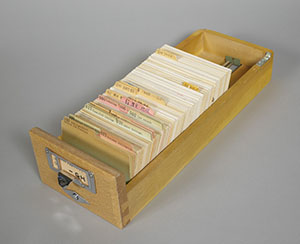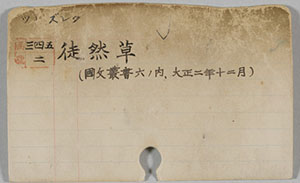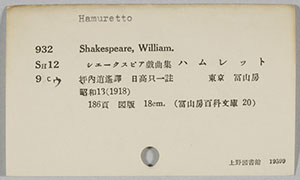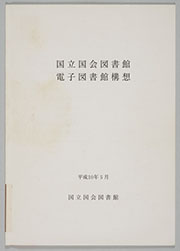70th Anniversary Commemorative Exhibit "A Treasure Box of Books - The 70-year History of the National Diet Library and Its Collections"
- A Treasure Box of Books
- Part 1 70 Years of the National Diet Library
- Section 3 The National Diet Library during the Heisei Era
Part 1 Section 3 The National Diet Library during the Heisei Era
The National Diet Library has experienced several turning points during the Heisei Era (1989-2019). In 2000, the International Library of Children's Literature was opened as Japan's first national library specifically for children. In 2002, the Kansai-kan of the National Diet Library was opened as a base for library services suited to an advanced information society. The digitization of materials and services has also progressed significantly. Then in 2011, the Great East Japan Earthquake reaffirmed the importance of the National Diet Library's role in ensuring the provision of materials and information to future generations.
22 Shin Kyoto kokumin bunka toshi koso by UMESAO Tadao
Chuokoron Volume 95 No. 4-1118, Chuokoron-sha (April 1980) [Z23-9]
This work discusses the concept for the creation of a "National Cultural City" in the suburbs of Kyoto-prefecture and the establishment of another National Diet Library. This article could be said to be a driving force behind the establishment of the Kansai-kan of the National Diet Library in Seika-cho, Soraku-gun, Kyoto prefecture in 2002.
23 Entries in the architectural design competition for the Kansai-kan of the National Diet Library (provisional name) Public Building Association (1997) [UL521-G5]
An architectural design competition was held for the construction of the Kansai-kan of the National Diet Library. Kengo Kuma, known for the design of the New National Stadium, and many other famous architects participated, with the proposal of Fumio Toki being selected as the top prize.
24 Kokusai Kodomo Toshokan jigyo kirokushu Ministry of Land, Infrastructure, Transport and Tourism. Kanto Regional Development Bureau Buildings Department (2002) [UL521-H5]
The Imperial Library (serving as the UENO Library, Branch of the National Diet Library since 1949), introduced in this exhibition, was renovated and reused as the building for the International Library of Children's Literature. In 2015, construction of the Annex (Arch Building) was also completed.
25 Card catalog drawer
26 Catalog card from public catalog of old Japanese and Chinese materials previously owned by the Imperial Library (handwritten)
27 Catalog card from public catalog of old Japanese and Chinese materials previously owned by the Imperial Library (printed)
In the past, in order to request materials, it was necessary to search for catalog cards for the materials you wanted from a number of catalog cards organized according to the material name, author name, and other information. Over time, these cards transitioned from being handwritten, to being printed. The printed catalog cards were distributed to libraries throughout Japan, helping to standardize public catalogs.
28 J-BISC Japan MARC on disc 2002 3rd ed. / 4th ed. edited by the National Diet Library, Japan Library Association (2002) [YH231-H550] [YH231-H551]
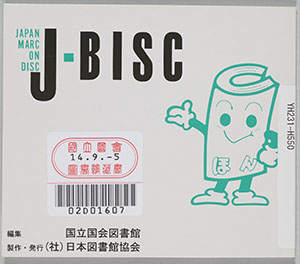
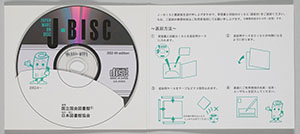
The provision of national bibliography data in a machine readable format using magnetic tape began in 1981. Later in 1988, the distribution of J-BISC, stored on CD-ROMs, also began. Then, in 2002, provision via the internet also became available.
29 National Diet Library Electronic Library Concept by the National Diet Library, National Diet Library (1998) [UL214-G8]
This is a concept which illustrates the ideal state for an electronic library which the National Diet Library should bring about. It lists a number of goals which would later be achieved, such as building the "collections" of the electronic library by collecting digitally published works and digitizing printed materials, and digitizing for widespread distribution to citizens.
- The Great East Japan Earthquake
-
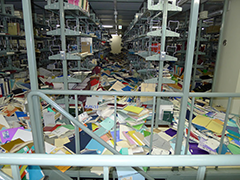 The stacks of the National Diet Library on the day following the earthquake
The stacks of the National Diet Library on the day following the earthquakeOn March 11, 2011, a massive magnitude 9.0 earthquake struck Japan.
The National Diet Library Great East Japan Earthquake Archive (Nickname: HINAGIKU) was commenced on March 7, 2013, in order to convey the records of and lessons learned from the Great East Japan Earthquake to later generations and to make good use of them for recovery and revitalization projects for stricken areas, as well as in future disaster prevention and mitigation measures.
"HINAGIKU" accumulates the records of those who strenuously worked to help recovery in the disaster-stricken areas. The so-called "wall newspaper," the Ishinomaki Hibi Shinbun, which published handwritten newspapers on wall posters when printing machines were unusable, is one of the prime examples.
The archive also includes records on the restoration carried out as part of the Great East Japan Earthquake recovery support activities of the Yoshida-ke monjo, designated as a prefectural cultural property of Iwate, which was damaged during the disaster.
